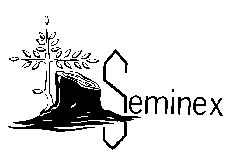
The Lutheran Church – Missouri Synod (LCMS), also known as the Missouri Synod, is an orthodox, traditional, confessional Lutheran denomination in the United States. With 1.8 million members as of 2021, it is the second-largest Lutheran body in the United States, behind the Evangelical Lutheran Church in America. The LCMS was organized in 1847 at a meeting in Chicago, Illinois, as the German Evangelical Lutheran Synod of Missouri, Ohio, and Other States, a name which partially reflected the geographic locations of the founding congregations.
The Evangelical Lutheran Church in America (ELCA) is a mainline Protestant Lutheran church headquartered in Chicago, Illinois. The ELCA was officially formed on January 1, 1988, by the merging of three Lutheran church bodies. As of 2022, it has approximately 2.9 million baptized members in 8,640 congregations.

The Wisconsin Evangelical Lutheran Synod (WELS), also referred to simply as the Wisconsin Synod, is an American Confessional Lutheran denomination of Christianity. Characterized as theologically conservative, it was founded in 1850 in Milwaukee, Wisconsin.
John H. Tietjen was a Lutheran clergyman, theologian, and national church leader in the United States. He is best known both for his role in the Seminex controversy which roiled the Lutheran Church–Missouri Synod (LCMS) in the mid-1970s, and for his efforts on behalf of Lutheran unity that resulted in the formation of the Evangelical Lutheran Church in America (ELCA).

Seminex is the widely used abbreviation for Concordia Seminary in Exile, which existed from 1974 to 1987 after a schism in the Lutheran Church–Missouri Synod (LCMS). The seminary in exile was formed due to the ongoing Fundamentalist–Modernist Controversy that was dividing Protestant churches in the United States. At issue were foundational disagreements on the authority of Scripture and the role of Christianity. During the 1960s, many clergy and members of the LCMS grew concerned about the direction of education at their flagship seminary, Concordia Seminary, in St. Louis, Missouri. Professors at Concordia Seminary had, in the 1950s and 1960s, begun to utilize the historical-critical method to analyze the Bible rather than the traditional historical-grammatical method that considered scripture to be the inerrant Word of God.

The American Lutheran Church (ALC) was a Christian Protestant denomination in the United States and Canada that existed from 1960 to 1987. Its headquarters were in Minneapolis, Minnesota. Upon its formation in 1960, The ALC designated Augsburg Publishing House, also located in Minneapolis, as the church publisher. The Lutheran Standard was the official magazine of The ALC.
1517 Media, formerly Augsburg Fortress Press, is the official publishing house of the Evangelical Lutheran Church in America (ELCA). It also publishes for the Evangelical Lutheran Church in Canada as Augsburg Fortress Canada. Headquartered on South Fifth Street in Minneapolis, Minnesota, in the former headquarters of the American Lutheran Church, Augsburg Fortress publishes Living Lutheran, the Lutheran Book of Worship (1978), the Lutheran Study Bible, and the Evangelical Lutheran Worship (2006), as well as a range of academic, reference, and educational books. Tim Blevins has served as the CEO of 1517 Media since August, 2018. Beth Lewis served as the CEO of Augsburg Fortress since September 3, 2002.
The Association of Evangelical Lutheran Churches (AELC) was a U.S. church body that existed from 1976 through the end of 1987. The AELC formed when approximately 250 dissident congregations withdrew from the Lutheran Church–Missouri Synod (LCMS) in 1976, and ended as an independent body when it became part of the new Evangelical Lutheran Church in America (ELCA) on January 1, 1988.
The Lutheran Church in America (LCA) was an American and Canadian Lutheran church body that existed from 1962 to 1987. It was headquartered in New York City and its publishing house was Fortress Press.
Evangelical Lutherans in Mission (ELIM) was a liberal caucus within the Lutheran Church–Missouri Synod (LCMS). It was formed in 1973 as an oppositional group of clergy following sweeping victories by Jacob Aall Ottesen Preus II and the LCMS's conservative wing, known as Confessional Lutherans, at the synod's 1973 convention in New Orleans. It was not considered a major issue in the LCMS when it began because it originally lacked significant lay support. ELIM gained further momentum in the wake of the 1974 Seminex controversy at Concordia Seminary in St. Louis, Missouri. The organization dedicated a large portion of its resources to supporting the break-away Seminex institution. Only after the Seminex controversy did ELIM begin to gain lay support. However, immediately after the Seminex controversy both the Confessional Lutherans and the ELIM claimed they did not want a schism. But after Preus was easily reelected as president of the LCMS in 1976 ELIM decided to become a confessing movement within the LCMS.

The Evangelical Lutheran Synodical Conference of North America, often known simply as the Synodical Conference, was an association of Lutheran synods that professed a complete adherence to the Lutheran Confessions and doctrinal unity with each other. Founded in 1872, its membership fluctuated as various synods joined and left it. Due to doctrinal disagreements with the Lutheran Church–Missouri Synod (LCMS), the Evangelical Lutheran Synod (ELS) and the Wisconsin Evangelical Lutheran Synod (WELS) left the conference in 1963. It was dissolved in 1967 and the other remaining member, the Synod of Evangelical Lutheran Churches, merged into the LCMS in 1971.
The Evangelical Lutheran Church (ELC) was a Lutheran denomination that existed from 1917, when it was founded as the Norwegian Lutheran Church of America (NLCA), until 1960, when it joined two other church bodies to form the second American Lutheran Church.

The Lutheran Student Movement - United States of America (LSM-USA) is a student-led organization of Lutheran college students. The movement's staff and resources are housed at the Churchwide Office of the Evangelical Lutheran Church in America in Chicago, Illinois.
The United Lutheran Church in America (ULCA) was established in 1918 in commemoration of the 400th anniversary of the Protestant Reformation after negotiations among several American Lutheran national synods resulted in the merger of three German-language synods: the General Synod, the General Council (1867), and the United Synod of the South (1863). The Slovak Zion Synod (1919) joined the ULCA in 1920. The Icelandic Synod (1885) also joined the United Lutheran Church in America in 1942. It was the largest Lutheran denomination in the United States for most of the first half of the 20th century.
Jacob Aall Ottesen Preus II was an American Lutheran pastor, professor, author, seminary president and church denominational president. He served as the eighth president of the Lutheran Church–Missouri Synod (LCMS) from 1969 to 1981. He was a major figure in the "Seminex" theological/political controversy, which resulted in a schism in the LCMS during the early 1970s.
The Evangelical Lutheran Joint Synod of Ohio and Other States, commonly known as the Joint Synod of Ohio or the Ohio Synod, was a German-language Lutheran denomination whose congregations were originally located primarily in the U.S. state of Ohio, later expanding to most parts of the United States. The synod was formed on September 14, 1818, and adopted the name Evangelical Lutheran Joint Synod of Ohio and Other States by about 1850. It used that name or slight variants until it merged with the Iowa Synod and the Buffalo Synod in 1930 to form the first American Lutheran Church (ALC), 1930–1960.
Lutheranism was first introduced to Mexico in the 1850s, when German-American Lutherans began serving German immigrants in Mexico, though mission work among the non-German population in Mexico did not begin until the 1940s. Today there are five Lutheran church bodies in Mexico—the Mexican Lutheran Church, the Lutheran Synod of Mexico, the Confessional Evangelical Lutheran Church—Mexico, the Evangelical Lutheran Church of Mexico (unaffiliated), and the Lutheran Apostolic Alliance of Mexico (unaffiliated)—and several independent congregations.

St. John's Lutheran Church is a member congregation of the American Association of Lutheran Churches (AALC) in Pocahontas, Missouri.
The National Lutheran Council (NLC) was a cooperative agency of most of the Lutheran church bodies in the United States. It was established in 1918 and was replaced in 1966 by the Lutheran Council in the United States of America.
The following is a timeline of significant events in the history of the Lutheran Church – Missouri Synod.




